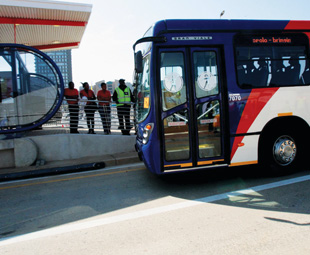Hit or miss?

A recent study assessed whether Johannesburg’s bus rapid transit (BRT) system,
Rea Vaya, gives its riders what they want. It makes for some interesting reading
BRT systems are commonly vilified for the high cost of creating and operating them, comparatively low passenger numbers and poor integration. One cause of poor passenger attraction among integrated public transport network (IPTN) systems is that they do not offer sufficiently attractive services, given the other alternatives available to potential passengers, according to Christo Venter, associate professor in the Department of Civil Engineering at the University of Pretoria, where he teaches transport engineering and planning.
Venter has endeavoured to examine the value proposition of IPTN systems against the stated needs and preferences of passengers. He drew on a recent combined, revealed and stated preference survey of 1 208 people in the City of Johannesburg (COJ), and studied actual choice behaviour in the existing BRT system.
“By studying the behaviour of commuters in areas where BRT is operated, a more realistic understanding of the drivers of the actual preferences and choices of commuters may be obtained under real market conditions,” Venter explains.
The surveys were clustered in eight areas ranging from Midrand in the north, to Orange Farm in the far south. All major modes of transport were looked at and both work and non-work trips were covered.
As the study was conducted as a part of the development of an Integrated Transport Network strategy to guide further deployment of the BRT and related services in coming years, it was aimed at generating a broader understanding of what passengers want, and of how this might differ across user groups.
Segmentation
 This was achieved by segmenting the commuter market according to people’s current choices and their willingness to consider new BRT alternatives. “This segmentation leads to an enhanced understanding of mode captivity, the limits of what BRT might realistically be able to achieve (in terms of attracting users), and which features are needed to make new public transport services attractive to different users,” says Venter.
This was achieved by segmenting the commuter market according to people’s current choices and their willingness to consider new BRT alternatives. “This segmentation leads to an enhanced understanding of mode captivity, the limits of what BRT might realistically be able to achieve (in terms of attracting users), and which features are needed to make new public transport services attractive to different users,” says Venter.
Four market segments were defined:
• Lifestyle car captives: people who use cars, due to personal, lifestyle or activity-related factors. These people are highly unlikely to use public transport, no matter how good the service is;
• Availability car captives: people who use cars because of the current unavailability of alternatives, but who might be willing to switch to public transport (or become choosers) in future, should an acceptable option become available;
• Choosers: people with both a car and at least one public transport option available for their trip;
• Public transport captives: people with one or more public transport options available, but no car available for a specific trip at a specific time.
“Of the 2,3-million daily motorised trips in the COJ, about half are captive to public transport – made without the option of a car. Just more than a quarter are classified as car-captive trips (about four out of every ten car captives – 250 000 – are classified as availability captive).
“The remaining 22 percent are classified as chooser trips. It follows that, of trips where the car is available (chooser plus car captive), just more than half feel they have no alternative but to drive,” notes Venter.
Time and money
The findings suggest that, in terms of their daily travel, most potential passengers have a very limited willingness to pay for saving travel time and are much more sensitive to price changes than to speed changes.
“This points to the limitations of the BRT design paradigm, which is heavily oriented towards raising travel speeds via segregated bus lanes and fully enclosed stations; yet is unable to recover the costs of doing so from the average passenger,” notes Venter.
However, this does not apply to all potential passengers. He suggests, therefore, that there must be a market for differentiated services – such as express or premium services – for which a higher fare can be charged.
 Third, it was found that potential passengers attach more importance to shorter walking and waiting times than to faster speeds once on-board a vehicle. Venter says that this finding is universal among public transport users internationally.
Third, it was found that potential passengers attach more importance to shorter walking and waiting times than to faster speeds once on-board a vehicle. Venter says that this finding is universal among public transport users internationally.
“From the passenger’s perspective, having services with reasonable frequencies (with low waiting times), and with enough penetration and network coverage to reduce walking distances, are at least as important as short travel times.
“It is interesting to note that minibus taxis tend to get these priorities exactly right, which helps to explain their popularity,” Venter notes. “Given the relatively low densities in which local BRT systems currently tend to operate, it might be more appropriate to spend money on increasing network coverage and frequencies, and improving the waiting experience with adequate shelters, than to invest heavily in a network of segregated busways,” he adds.
Furthermore, Venter says, one transfer on BRT equates to the equivalent of less than ten percent of present BRT fares. “This suggests that, for the average passenger, more transferring would be an acceptable price to pay for having a more integrated public transport system with better coverage, provided the feeders and transfers are carefully designed and managed.”
A fourth implication is that ridership forecasts tend to over-predict passenger numbers for time-saving modes such as BRT. “Forecasts fail to recognise that a portion of the market has no willingness to pay for BRT, due to lifestyle and preference factors. By lumping car captives with individuals who place a high value on time, the mistaken conclusion is reached that, if only BRT can be fast enough, it will attract these passengers.
“This might be one of the reasons why predicted ridership levels have failed to materialise for BRT systems such as Rea Vaya,” Venter explains.
BRT versus the competition
While people with a car ranked travelling by car as more attractive than BRT, they did see BRT as a superior option to all other public transport modes (apart from the Gautrain); especially when viewed against regular bus services (including Putco and Metrobus).
“The most important finding is that, for those passengers who actively made a choice between BRT and a minibus taxi, BRT significantly outperforms minibus-taxi services (on average) in terms of fare, travel time and number of transfers, despite requiring slightly longer walking and waiting times.
“The qualitative aspects that distinguish Rea Vaya from the minibus-taxi mode – perhaps greater safety, comfort, payment convenience, and so forth – are worth much in the passenger’s mind and exert an important influence on the decision to use BRT,” says Venter.
He suggests that BRT authorities should have a better understanding of these qualitative aspects, and pay very close attention to the quality of service in the design and (especially) the operation of the service.
“Service quality is primarily an outcome of how well a service is operated. This is, arguably, the more difficult part of running a successful public transport service.
“It also means that, no matter how fast and affordable BRT is, it will struggle to retain and increase its market share if the service it offers is not perceived to be of a high quality,” he concludes.
Published by
Focus on Transport
focusmagsa




 !
From 1 Apri
!
From 1 Apri

 Big news from FOCUS on Transport + Logist
Big news from FOCUS on Transport + Logist





 FUSO: Driving the Future of Mobile Healthc
FUSO: Driving the Future of Mobile Healthc



 A brand
A brand




 Wondering about the maximum legal load for a
Wondering about the maximum legal load for a 
 The MAN hTGX powered by a hydrogen combus
The MAN hTGX powered by a hydrogen combus

 Exciting News for South African Operators
Exciting News for South African Operators
